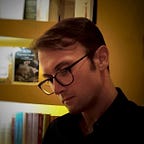In 1967, when my father, Frederick (“Rick”) Hart took a job as a clerk in the mail room at Washington National Cathedral, he did so primarily for the purpose of pestering the Cathedral’s master stone carver, Roger Morigi.
Back then, Rick was an aspiring sculptor. He wanted Morigi to take him on as an apprentice, and teach him the ancient techniques of his trade.
In time, it worked. When Rick showed Morigi what he could do, the master carver was impressed. Morigi became a mentor to Rick.
First, Morigi put Rick to work on ornaments like ceiling bosses and gargoyles. Gargoyles have long been a distinctive feature of Gothic architecture and because they were so high up, and far from view, Rick’s rookie mistakes would be less noticeable there.
As his training progressed, Rick acquired more and more responsibilities. After carving a gargoyle in the shape of an owl, he sculpted another in the form of the satyr, Pan, god of the wild.
In addition to gargoyles, Rick created similar Gothic architectural sculptures known as grotesques. One grotesque he created displays a dragon in flight, clutching a skull and violin.
Afterwards, Rick kept a plaster cast of this grotesque, as well as a plaster cast of his Pan gargoyle. He kept these two plaster statues on display year after year, decade after decade, in each of the studios he occupied. Throughout the rest of his career, these two statues would serve as reminders of his early days as a sculptor, and of that important period of training he served under Morigi.
Eventually, Rick would be responsible for a number of key sculptural elements within the Cathedral’s most cherished spaces. By the time Morigi retired, Rick was sculpting the statues adorning the west facade, the Creation Sculptures ensemble, a massive collection of statues comprising three larger-than-life-size trumeau figures, together with three monumental tympanum reliefs which tower over the main entrance to the Cathedral itself.
In the 1970s, Rick gave up his job as a stone carver at the Cathedral, in order to explore working in other sculptural mediums. At the time, the Cathedral was not yet complete. It was still a work-in-progress — just as it had been for almost seven decades.
Built according to traditional medieval methods, in the style of Gothic cathedrals of old, Washington National Cathedral had become, by the final quarter of the twentieth century, something of an architectural oddity. All around, more modern modes of architecture had long been in vogue, modes of architecture dominated by machine-manufactured elements, and plain surfaces. Throughout Washington, as throughout much of the modern urban landscape, the tradition of hand-crafted architectural decoration seemed to be on the verge of disappearing.
In one of the very first opportunities he ever had to read his name in print, Rick was interviewed by a reporter about some of his early work on the Cathedral. It ran under the headline, “He May Be Last Gargoyle Carver.” According to the reporter, Rick was “destined to become the last of the gargoyle virtuosos.” In a quote, Rick declared the Cathedral “the last stand for this kind of workmanship in stone.”
As it happened, Rick was not the last of the gargoyle carvers. The tradition survives. He would be outlived by his own assistant, Jay Hall Carpenter, now an accomplished sculptor in his own right.
Among his many works, Carpenter is responsible for sculpting what may be the most famous of all the Gothic architectural sculptures at Washington National Cathedral: the Darth Vader grotesque.
Hart, Frederick, et al. Frederick Hart: Sculptor. Hudson Hill, 1994.
